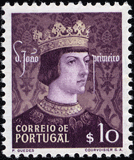- Joined
- Aug 13, 2004
- Messages
- 27,113
- City
- São Paulo
- Country
- Brazil
João I, King of Portugal and the Algarves, Lord of Ceuta (Lisbon, 11 April 1357 - Lisbon,14 August 1433); married in Porto on 2 February 1387, Princess Philippa of Lancaster (Leicester Castle, 2 May 1359 - Odivelas, 19 July 1415)
Reign: 1433 - 1433
Predecessor: King Fernando I of Portugal and the Algarves (disputed: Queen Beatriz of Portugal)
Succeeded by: King Duarte I of Portugal and the Algarves
Children: Princess Branca, Prince Alfonso of Portugal and King Duarte I of Portugal, Prince Pedro of Portugal, Duke of Coimbra; Prince Henrique of Portugal, Duke of Viseu; Duchess Isabel of Burgundy Princess Branca of Portugal, Prince João of Portugal, Counstable of Portugal and Prince Fenando of Protugal 'Infante Santo'
Parents João: King Pedro I of Portugal and Teresa Lourenço
Parents Philippa: Prince John 'of Gaunt' of England, 1st Duke of Lancaster and Princess Blanche of Lancaster
Siblings João: Prince Luís of Portugal, Princess Maria of Aragon, Marchioness of Tortosa; King Fernando I of Portugal, Alfonso of Portugal, Princess Beatriz of Castille, Countess of Alburquerque and Haro; Prince João of Portugal, Lord of Porto de Mós, Ceia and Montelonso, and also Duke of Valencia de Campos; Prince Dinis of Portugal, Lord of Villar-Dompardo, Cifuentes, Escalona and Alvar de Tormes
Siblings Philippa: Prince John of Lancaster, Elizabeth, Countess Pembroke, later Duchess of Exeter, later Baroness Fanhope and Milbroke; Prince Edward ad Prince John of Lancaster, King Henry IV of England, Princess Isabel of Lancaster, Queen Katherine of Castille
Reign: 1433 - 1433
Predecessor: King Fernando I of Portugal and the Algarves (disputed: Queen Beatriz of Portugal)
Succeeded by: King Duarte I of Portugal and the Algarves
Children: Princess Branca, Prince Alfonso of Portugal and King Duarte I of Portugal, Prince Pedro of Portugal, Duke of Coimbra; Prince Henrique of Portugal, Duke of Viseu; Duchess Isabel of Burgundy Princess Branca of Portugal, Prince João of Portugal, Counstable of Portugal and Prince Fenando of Protugal 'Infante Santo'
Parents João: King Pedro I of Portugal and Teresa Lourenço
Parents Philippa: Prince John 'of Gaunt' of England, 1st Duke of Lancaster and Princess Blanche of Lancaster
Siblings João: Prince Luís of Portugal, Princess Maria of Aragon, Marchioness of Tortosa; King Fernando I of Portugal, Alfonso of Portugal, Princess Beatriz of Castille, Countess of Alburquerque and Haro; Prince João of Portugal, Lord of Porto de Mós, Ceia and Montelonso, and also Duke of Valencia de Campos; Prince Dinis of Portugal, Lord of Villar-Dompardo, Cifuentes, Escalona and Alvar de Tormes
Siblings Philippa: Prince John of Lancaster, Elizabeth, Countess Pembroke, later Duchess of Exeter, later Baroness Fanhope and Milbroke; Prince Edward ad Prince John of Lancaster, King Henry IV of England, Princess Isabel of Lancaster, Queen Katherine of Castille
Last edited:



